Cherry Blossom
RSP 11329
Grower: Yabba Cannaba
General Information
- Sample Name
- CG7
- Accession Date
- October 17, 2019
- Reported Plant Sex
- Female
- Report Type
- StrainSEEK v2 3.2Mb
- DNA Extracted From
- Stem
The strain rarity visualization shows how distant the strain is from the other cultivars in the Kannapedia database. The y-axis represents genetic distance, getting farther as you go up. The width of the visualization at any position along the y-axis shows how many strains there are in the database at that genetic distance. So, a common strain will have a more bottom-heavy shape, while uncommon and rare cultivars will have a visualization that is generally shifted towards the top.
Chemical Information
Cannabinoid and terpenoid information provided by the grower.
Cannabinoids
No information provided.
Terpenoids
No information provided.
Genetic Information
- Plant Type
- Type III
File Downloads
The bell curve in the heterozygosity visualization shows the distribution of heterozygosity levels for cannabis cultivars in the Kannapedia database. The green line shows where this particular strain fits within the distribution. Heterozygosity is associated with heterosis (aka hybrid vigor) but also leads to the production of more variable offspring. When plants have two genetically different parents, heterozygosity levels will be higher than if it has been inbred or backcrossed repeatedly.
The ratio of reads mapped to Y-contigs to reads mapped to the whole Cannabis genome (Y-ratios) has been demonstrated to be strongly correlated with plant sex typing. This plot shows the distribution of Y-ratios for all samples in our database which were sequenced with the same method (panel or WGS) as this sample and where this sample falls in the distribution.
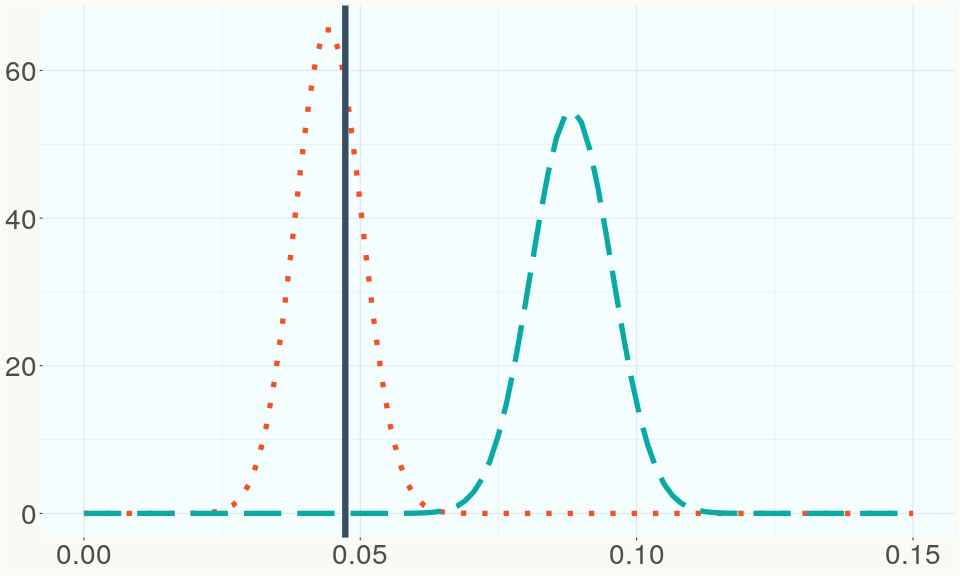
This chart represents the Illumina sequence coverage over the Bt/Bd allele. These are the three regions in the cannabis genome that impact THCA, CBDA, CBGA production. Coverage over the Active CBDAS gene is highly correlated with Type II and Type III plants as described by Etienne de Meijer. Coverage over the THCA gene is highly correlated with Type I and Type II plants but is anti-correlated with Type III plants. Type I plants require coverage over the inactive CBDA loci and no coverage over the Active CBDA gene. Lack of coverage over the Active CBDA and Active THCA allele are presumed to be Type IV plants (CBGA dominant). While deletions of entire THCAS and CBDAS genes are the most common Bt:Bd alleles observed, it is possible to have plants with these genes where functional expression of the enzyme is disrupted by deactivating point mutations (Kojoma et al. 2006).
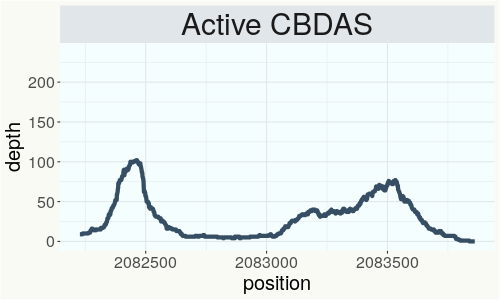
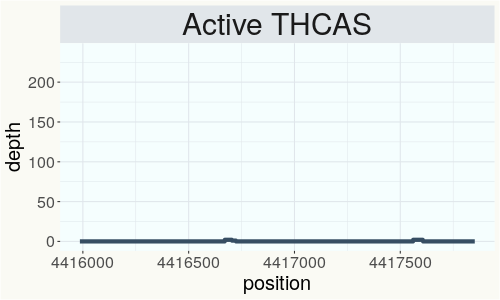
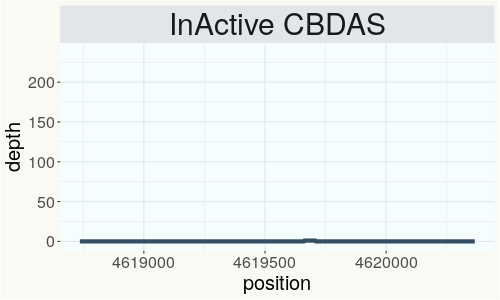
This chart represents the Illumina sequence coverage over the CBCA synthase gene.
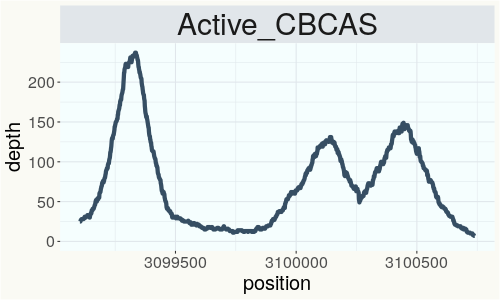
Variants (THCAS, CBDAS, and CBCAS)
No variants to report
Variants (Select Genes of Interest)
| GPPs1 |
c.845_848del |
p.Glu282fs | frameshift variant | high | contig676 | 169629 | TGAAA/T |
|
| PKSG-4a | c.493G>A | p.Gly165Ser | missense variant | moderate | contig700 | 1937904 | G/A |
|
| PKSG-4a |
c.1191_1193d |
p.Tyr398del | disruptive inframe deletion | moderate | contig700 | 1938600 | AATT/A |
|
| PKSG-2a | c.1117A>G | p.Ile373Val | missense variant | moderate | contig700 | 1944273 | T/C | |
| PKSG-2b | c.1117A>G | p.Ile373Val | missense variant | moderate | contig700 | 1950521 | T/C | |
| PKSG-4b | c.496A>G | p.Lys166Glu | missense variant | moderate | contig700 | 2721177 | T/C | |
| PKSG-4b | c.489delT | p.Phe163fs | frameshift variant | high | contig700 | 2721183 | CA/C | |
| PKSG-4b | c.485A>G | p.Lys162Arg | missense variant | moderate | contig700 | 2721188 | T/C | |
| PKSG-4b |
c.352_355del |
p.Thr118fs | frameshift variant | high | contig700 | 2721317 | CCTGT/C |
|
| PKSG-4b | c.324A>C | p.Glu108Asp | missense variant | moderate | contig700 | 2721349 | T/G |
|
| PKSG-4b | c.323A>G | p.Glu108Gly | missense variant | moderate | contig700 | 2721350 | T/C |
|
| DXR-2 | c.1319T>C | p.Ile440Thr | missense variant | moderate | contig380 | 285250 | A/G |
|
| aPT4 | c.97T>C | p.Tyr33His | missense variant | moderate | contig121 | 2828753 | T/C |
|
| aPT4 | c.153A>C | p.Lys51Asn | missense variant | moderate | contig121 | 2828809 | A/C |
|
| aPT4 |
c.235_236del |
p.Val79fs | frameshift variant | high | contig121 | 2829030 | ATG/A |
|
| aPT4 | c.238delT | p.Ser80fs | frameshift variant | high | contig121 | 2829034 | AT/A |
|
| aPT4 | c.302A>G | p.Asn101Ser | missense variant | moderate | contig121 | 2829099 | A/G |
|
| aPT4 |
c.744+1_744+ |
splice donor variant & splice region variant & intron variant | high | contig121 | 2831022 |
GGTAATTTATTT |
|
Nearest genetic relatives (All Samples)
- 0.151 Cherry Blossom (RSP11306)
- 0.152 Cherry Blossom (RSP11326)
- 0.166 Cherry Blossom (RSP11304)
- 0.166 Cherry Blossom (RSP11315)
- 0.179 Cherry Blossom (RSP11313)
- 0.181 Cherry Blossom (RSP11322)
- 0.202 Cherry Blossom (RSP11299)
- 0.206 Cherry Blossom (RSP11331)
- 0.215 Cherry Blossom CBG (RSP11303)
- 0.217 Lift (RSP11378)
- 0.220 Cherry Blossom (RSP11325)
- 0.221 Cherry Blossom (RSP11320)
- 0.222 Cherry Blossom (RSP11324)
- 0.229 Cherry Wine (RSP11307)
- 0.230 Cherry Wine (RSP11305)
- 0.231 Cherry Blossom (RSP11316)
- 0.234 Electra (RSP11366)
- 0.239 Domnesia (RSP11184)
- 0.241 Cherry Blossom (RSP11302)
- 0.241 Lifter (RSP11365)
Most genetically distant strains (All Samples)
- 0.484 Northern Lights (RSP11501)
- 0.474 Fatso (RSP11741)
- 0.474 Chem 91 (RSP11185)
- 0.462 JL 3rd Gen Mother (RSP11214)
- 0.459 JL yellow (RSP11075)
- 0.455 BagSeed (RSP12501)
- 0.450 Big Bud (SRR14708270)
- 0.450 Cherry Blossom (RSP11328)
- 0.448 JL 4th Gen 1 (RSP11193)
- 0.447 Right Mark (RSP11628)
- 0.446 UP The Straits (RSP11260)
- 0.442 JL 3rd Gen Father (RSP11196)
- 0.441 RKM-2018-012 (RSP11103)
- 0.439 Cherry Blossom (RSP11318)
- 0.438 Star Dawg (RSP11352)
- 0.437 White Label 1 (RSP11336)
- 0.437 Cherry Lime Runtz (RSP12486)
- 0.437 Delta-llosa (SRR14708272)
- 0.436 Ruderalis Indica (SRR14708267)
- 0.434 Juicy Gummy x Royal Kush (RSP12484)
Nearest genetic relative in Phylos dataset
- Overlapping SNPs:
- 63
- Concordance:
- 38
Nearest genetic relative in Lynch dataset
- Overlapping SNPs:
- 4
- Concordance:
- 4
Blockchain Registration Information
- Transaction ID
-
eca972e82e35e99b
310333a38df27053 ecbf99a92af84d02 2ab2271e9780cc63 - Stamping Certificate
- Download PDF (870.0 KB)
- SHASUM Hash
-
a14c16f0eb39923833a6b2b4bfa75ac4 d30de367ca959bdf 8a26c233f96fdf75